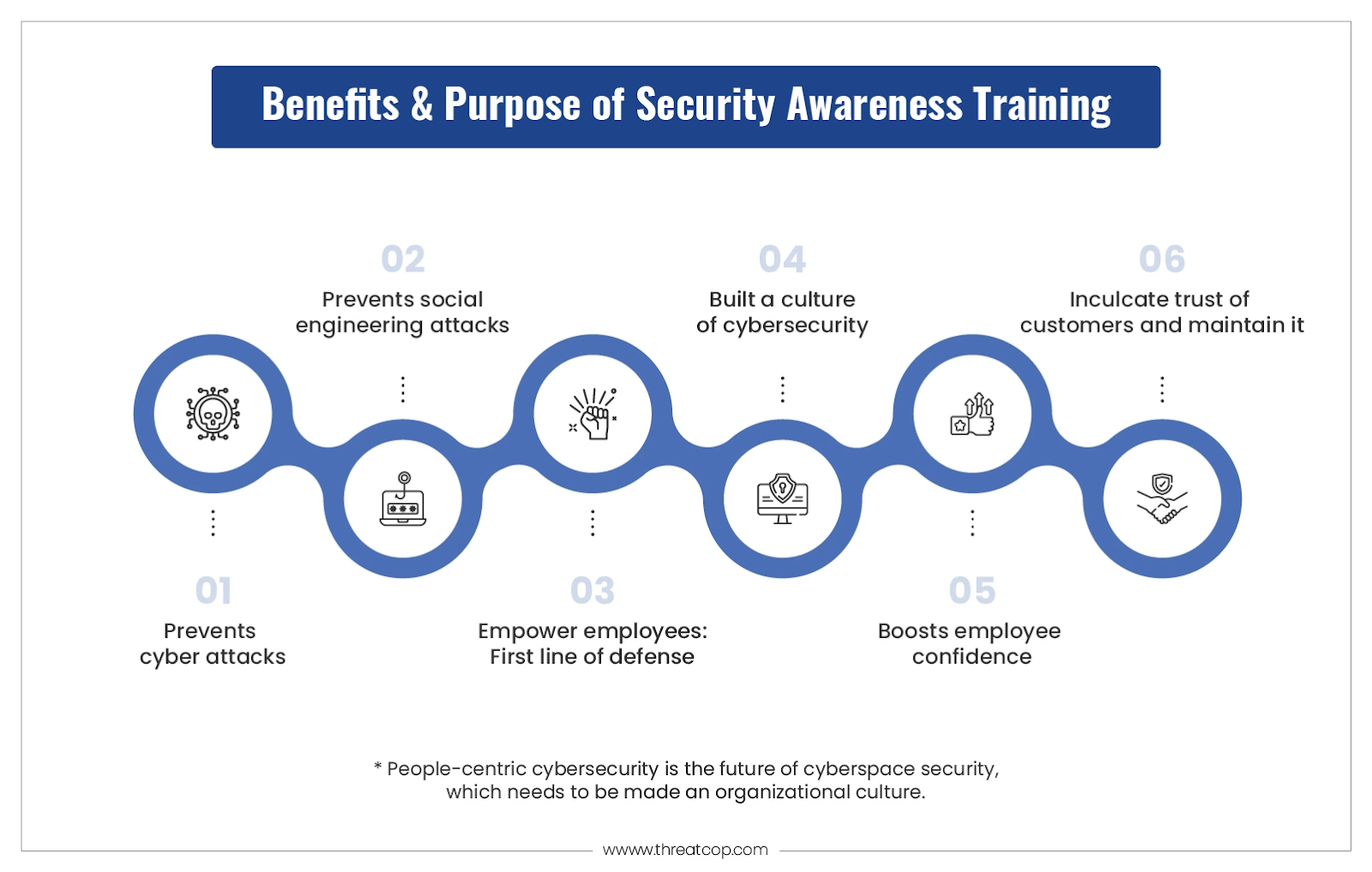Introduction
Cybersecurity threats are escalating rapidly, making headlines almost daily. A recent report from Cybersecurity Ventures predicts that global cybercrime damages will reach $8 trillion in 2023 and could climb to $10.5 trillion by 2025 (Cybersecurity Ventures, 2023). As organisations increasingly rely on technology to operate, ensuring the security of sensitive information has never been more crucial.
Cybersecurity awareness training educates employees about various security threats and how to respond effectively. This training is essential for fostering a security-conscious culture within organisations. A well-trained workforce can significantly reduce the risk of cyber incidents and improve a business’s overall security posture. However, many organisations need to pay more attention to the importance of this training and invest in it adequately.
This blog explores the growing cyber threat landscape, the critical role employees play in cybersecurity, the benefits of awareness training, key components of effective programs, implementation strategies, challenges faced, and future trends in cybersecurity training. Understanding these elements highlights why cybersecurity awareness training is a vital investment for any organisation seeking to protect its assets and reputation.
The Growing Cyber Threat Landscape
The cyber threat landscape has evolved dramatically, with cybercriminals employing increasingly sophisticated tactics. The FBI’s Internet Crime Complaint Center (IC3) reported over 800,000 cybercrime incidents in 2022, resulting in losses exceeding $6.9 billion (FBI IC3, 2023). These alarming statistics underscore the scale and severity of cyber threats businesses face today.
Phishing attacks are among the most prevalent threats. These scams trick employees into revealing sensitive information, such as passwords or financial data. According to a report by Proofpoint, 83% of organisations experienced phishing attacks in 2022, with attackers using social engineering tactics to manipulate employees into compliance (Proofpoint, 2023).
Ransomware is another significant threat. These attacks encrypt an organisation’s data, making it inaccessible until a ransom is paid. The 2023 Cybersecurity Statistics Report indicated a 41% increase in ransomware attacks compared to the previous year. Such attacks can lead to severe financial losses and reputational damage. For instance, a well-known software provider suffered a major ransomware attack in late 2022, resulting in operational disruptions and significant recovery costs.

Source: StealthLabs
Insider threats also pose considerable risks. These occur when employees, either maliciously or unintentionally, compromise the organisation’s security. A study by the Verizon Data Breach Investigations Report (DBIR) revealed that 30% of breaches were caused by insider threats in 2022 (Verizon, 2023).
The financial impact of cybercrime is staggering. According to a study by McKinsey, the average cost of a data breach in 2023 was estimated to be around $4.35 million for companies (McKinsey, 2023). As cyber threats grow in complexity and frequency, organisations must recognise that a robust cybersecurity strategy includes comprehensive employee training.
The Role of Employees in Cybersecurity
Employees play a crucial role in an organisation’s cybersecurity efforts, often acting as the first defence against threats. However, they can also be the weakest link without proper training and awareness. Understanding this dual role is vital for organisations striving to enhance their security posture.
The human factor in cybersecurity is significant. Employees can unknowingly open the door to cybercriminals through careless actions. For example, clicking on a malicious link in an email or using weak passwords can lead to data breaches. According to a study by the SANS Institute, 95% of cybersecurity incidents are due to human error, highlighting the need for effective training programs (SANS Institute, 2023).
Several high-profile breaches demonstrate how employee-related actions can have devastating consequences. One notable incident involved a major retail chain that suffered a massive data breach after an employee fell victim to a phishing scam. The attackers accessed sensitive customer data, resulting in significant financial losses and reputational damage.
The impact of employee negligence extends beyond immediate financial repercussions. Companies may face regulatory penalties, loss of customer trust, and a damaged brand reputation. A report from IBM revealed that companies with a strong security culture saw 50% fewer data breaches than those without such a culture (IBM, 2023). This statistic underscores the importance of investing in employee training to foster a sense of responsibility and vigilance regarding cybersecurity.
Organisations can transform employees from potential vulnerabilities into proactive defenders by empowering them with knowledge and skills. Training programs emphasising cybersecurity awareness can significantly reduce risks, enhance incident response, and protect the organisation’s assets.
Benefits of Cybersecurity Awareness Training
Investing in cybersecurity awareness training offers numerous benefits for organisations, creating a more resilient workforce equipped to handle potential threats.

Source: ThreatCop
Increased Awareness and Knowledge: One of the primary advantages of cybersecurity training is the heightened awareness it instils in employees. Training programs help employees recognise cyber threats like phishing scams, malware, and social engineering tactics. For example, after implementing a training program, a financial services company reported a 75% decrease in successful phishing attacks among its employees (CyberEdge Group, 2023). This knowledge equips employees to identify suspicious activity and take appropriate actions to mitigate risks.
Reduced Risk of Breaches: Research consistently shows that organisations with comprehensive cybersecurity training experience fewer security incidents. A study by Cybereason found that companies that conduct regular cybersecurity training are 50% less likely to suffer a data breach than those that do not invest in such initiatives (Cybereason, 2023). Organisations can significantly reduce the risk of successful attacks by empowering employees to understand their role in cybersecurity.
Enhanced Incident Response: Trained employees are better prepared to respond effectively to security incidents. They are more likely to follow established protocols and report suspicious activities promptly. This proactive approach can make a significant difference in minimising the impact of a cyber incident. For instance, a technology company implementing a cybersecurity awareness program noted that employees could identify and report a ransomware attack within minutes, preventing data loss and system downtime.
Fostering a Security Culture: Establishing a culture of cybersecurity is essential for long-term success. Training programs that emphasise the importance of cybersecurity create a sense of shared responsibility among employees. When individuals understand the potential consequences of their actions, they are more likely to prioritise security in their daily tasks. A survey by Gallup found that organisations with a strong cybersecurity culture reported 40% fewer incidents than those lacking such a culture (Gallup, 2023).
Moreover, fostering a security culture encourages employees to be vigilant and take ownership of their cybersecurity responsibilities. Regular training sessions, workshops, and awareness campaigns can reinforce the importance of cybersecurity, keeping it top of mind for employees.
Compliance and Regulatory Requirements: Many industries are subject to strict data protection and cybersecurity regulations. Training employees on these requirements ensures compliance and helps organisations avoid potential fines and legal issues. For example, the General Data Protection Regulation (GDPR) mandates that organisations provide adequate training to employees handling personal data. Failing to comply with such regulations can result in significant penalties.
Overall, cybersecurity awareness training benefits extend beyond merely reducing incidents. By investing in employee education, organisations can create a culture of security that enhances their resilience and ability to navigate the evolving cyber threat landscape.
Key Components of Effective Cybersecurity Awareness Training
Developing an effective cybersecurity awareness training program requires careful consideration of various components to ensure its success.
Curriculum Elements: A comprehensive training program should cover essential topics such as the basics of cybersecurity, recognising phishing attempts, secure password practices, and safe internet usage. Employees should understand how to handle sensitive information and recognize potential threats. Regular updates to the curriculum are vital to keep pace with the evolving threat landscape.
Interactive Learning Methods: Engaging employees through interactive learning methods can enhance training effectiveness. Traditional lectures may not capture attention or retention as effectively as hands-on training. Incorporating simulations, quizzes, and real-life scenarios allows employees to practice identifying threats in a safe environment. For example, conducting phishing simulations can help employees recognise phishing emails and understand how to respond.
Frequency and Updates: Cybersecurity training should not be a one-time event. Regular training sessions, at least once a year, ensure that employees remain aware of new threats and best practices. The training content should also be updated frequently to reflect cybercriminals’ latest trends and tactics. A study by the Cybersecurity & Infrastructure Security Agency (CISA) found that organisations with regular training updates experience 60% fewer security incidents than those with outdated training (CISA, 2023).
Assessment and Feedback: Evaluating the effectiveness of the training program is crucial. Organisations should implement assessments, such as quizzes or surveys, to gauge employees’ understanding and retention of the material. Collecting feedback from participants can provide insights into areas that need improvement. This feedback loop ensures that the training remains relevant and effective.
By incorporating these key components, organisations can create a robust cybersecurity awareness training program that equips employees with the knowledge and skills to protect themselves and the organisation from cyber threats.
Implementing Cybersecurity Awareness Training Programs
Implementing a successful cybersecurity awareness training program involves several steps to ensure its effectiveness and sustainability.
Steps to Develop a Training Program: Organizations should start with a needs assessment to identify specific training requirements. This assessment can involve evaluating existing knowledge gaps, analysing previous security incidents, and understanding regulatory obligations. Once the needs are identified, organisations can develop a tailored curriculum that addresses these areas.
Selecting appropriate content delivery methods is also essential. Options include in-person workshops, online courses, and interactive modules. Online training platforms offer flexibility, allowing employees to complete training at their own pace while still engaging with the material. According to a report from Skillsoft, 67% of employees prefer online training methods due to convenience (Skillsoft, 2023).
Choosing the Right Training Providers: Organizations that opt for external training resources should carefully evaluate potential providers. Look for providers with a solid reputation, proven track records, and content that aligns with your organisation’s needs. Additionally, consider whether the training material is regularly updated to reflect current threats and best practices.
Measuring Effectiveness: Assessing the effectiveness of the training program is critical for continuous improvement. Organisations can utilise various metrics, such as the number of reported phishing attempts, employee retention rates on training materials, and overall security incident frequency. Conducting pre and post-training assessments can also provide valuable insights into knowledge gains.
Furthermore, organisations should encourage a feedback culture, allowing employees to share their experiences with the training program. This feedback can help identify areas for improvement and ensure the training remains relevant and engaging.
Overcoming Challenges in Cybersecurity Training
Despite the importance of cybersecurity training, organisations often need help implementing these programs. Understanding and addressing these challenges is essential for fostering a successful training environment.
Common Barriers to Training: Employee resistance is among the most significant barriers. Some employees may view cybersecurity training as unnecessary, particularly if they feel confident in their technical skills. Additionally, budget constraints can limit the resources available for comprehensive training programs.
Strategies to Engage Employees: Organizations should focus on making the training relevant and relatable to combat resistance and promote engagement. Incorporating real-life examples, such as recent breaches in the news, can illustrate the importance of cybersecurity awareness. Gamification—using game-like elements in training—can also enhance engagement by making learning more enjoyable. According to a report by TalentLMS, 83% of employees feel more motivated to learn when training incorporates gamified elements (TalentLMS, 2023).
Another strategy is to highlight the personal impact of cybersecurity. Employees should understand how their actions contribute to the organisation’s overall security. Providing statistics about the potential consequences of data breaches—both for the organisation and individual employees—can foster a sense of responsibility.
Continuous Learning: Cybersecurity is a dynamic field that requires ongoing education. Organisations should not treat training as a one-time event but as an integral part of the company culture. Offering refresher courses and updates on emerging threats can keep cybersecurity awareness in employees’ minds. Regularly scheduled training sessions can help employees stay informed and vigilant.
Moreover, encouraging open communication about cybersecurity concerns can foster a supportive environment. Employees should feel comfortable reporting suspicious activities or asking questions about security practices without fear of reprimand.
Future Trends in Cybersecurity Training
As technology advances, cybersecurity training programs must evolve to meet emerging challenges.
Emerging Technologies in Training: Integrating technologies like artificial intelligence (AI) and virtual reality (VR) into training programs is becoming increasingly popular. AI can personalise training experiences based on individual learning styles, while VR offers immersive training environments that simulate real-world scenarios. These technologies can enhance engagement and retention by providing employees with hands-on experience in a controlled setting.
Adapting to Remote Work: The shift to remote and hybrid work environments has introduced new challenges for cybersecurity training. Organisations must adapt their training methods to reach remote employees effectively. Online training modules and interactive webinars can bridge this gap, ensuring all employees can access essential training resources regardless of location.
Predictions for Cybersecurity Training: In 2025 and beyond, organisations may increasingly prioritise ongoing training and real-time updates. As cyber threats continue to evolve, the need for continuous education will become paramount. Companies may invest in AI-driven platforms that provide real-time threat intelligence and training updates to inform employees of the latest security protocols.
Emphasising a culture of cybersecurity and prioritising ongoing training will be key factors in protecting organisations against future cyber threats.
Conclusion
The importance of cybersecurity awareness training for employees cannot be overstated. As cyber threats evolve, organisations must recognise that their workforce is a critical line of defence. By investing in comprehensive training programs, businesses can significantly reduce the risk of breaches and enhance their overall security posture.
Effective training can increase awareness, reduce incident rates, and improve incident response capabilities. Fostering a culture of cybersecurity ensures that employees take ownership of their responsibilities in safeguarding sensitive information.
Challenges such as employee resistance and budget constraints may arise, but organisations can overcome these obstacles with engaging and relevant training methods. By leveraging emerging technologies and adapting to the changing work environment, companies can create training programs that resonate with employees and empower them to contribute actively to cybersecurity efforts.
Ultimately, cybersecurity awareness training is not just an option—it’s necessary for any organisation that values its data and reputation. Businesses can confidently navigate the ever-evolving cyber threat landscape by committing to ongoing education and cultivating a proactive security culture.




